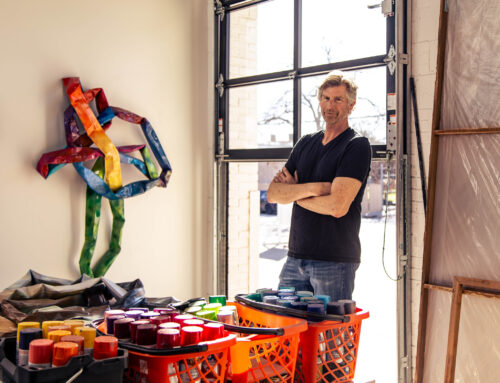A partially finished sculpture stands in Robert Hogan’s garage. Two men are visible, their bodies are not fully developed, but the details of their faces are clear, distinct versions of pictures pinned on the garage wall. His smaller “mockettes” – quarter life-size of what the originals will be – sit idly by on his worktable. Before the pieces are done, he’ll add another person to the two already there.
Hogan has faced the summer heat wave from inside this garage, constructing a sculpture for Blue Bell Creameries 100th Anniversary next summer. The sculpture depicts the first general manager of Blue Bell, E.F. Kruse, and his two sons, Ed and Howard.
Jim Hayhurst, who works for Blue Bell public relations, was in charge of finding two sculptors to work on projects for the anniversary. After seeing Hogan’s sculptures of Astros players Craig Biggio and Jeff Bagwell at Minute Maid Park in Houston, and checking out his website, bronzeartbyhogan.com, Hayhurst was impressed with how well he sculpted faces. So he chose Hogan to do the project entitled “Kruse Men.”
The sculpture will be unveiled next June or July at the plant in Brenham, Texas. Blue Bell has built a sculpture garden where Hogan’s sculpture and the other will be displayed.
Though he’s now being chosen for such commissions, Hogan didn’t start as an artist. For 24 years, he was in the clothing industry and was working as a clothing rep when he saw the work of another bronze sculptor, Scott Rodgers. In 1993, Hogan and his wife were enjoying the festivities at the Cottonwood Art Show in Richardson when they came upon Rogers’ booth. Hogan turned to his wife and said, ‘I can do that.’ She responded, “No, you can’t even draw.”
It’s true – Hogan can’t draw – but he can see things three dimensionally, he says, so he doesn’t need to use drawings for his work.
Hogan decided to leave his old career behind, but that initial spontaneity gave away to a slow start.
“It took me from September to December to actually get up the nerve to do something,” Hogan says. “One day it was cloudy, raining a little bit, and I decided that was the day.”
He’s never taken any classes or read any books on sculpting. It’s a natural gift, or as Hogan says, “I have a knack for figuring out where to go next.”
He constructs his pieces by shaping block of Styrofoam with various tools. Clay is the next step in the process. Hogan styles clay onto the Styrofoam to form the piece. He then adds clay to this for detail and definition. When Hogan’s satisfied with his work, it goes to a foundry in Dublin, Texas, where it is bronzed.
It was his first trip to the foundry where Hogan got encouragement to continue with his career.
He was putting the finished touches on that first project when a tour came through. A curious onlooker asked Hogan how long he’d been sculpting.
“I said about two months. They said, ‘No, how long have you had your sculpting career?’ I said, ‘This is my first piece.’”
The piece was a rooster crowing, which he titled “The Party’s Over.”
For Hogan’s new vocation, however, the party was just getting started.






